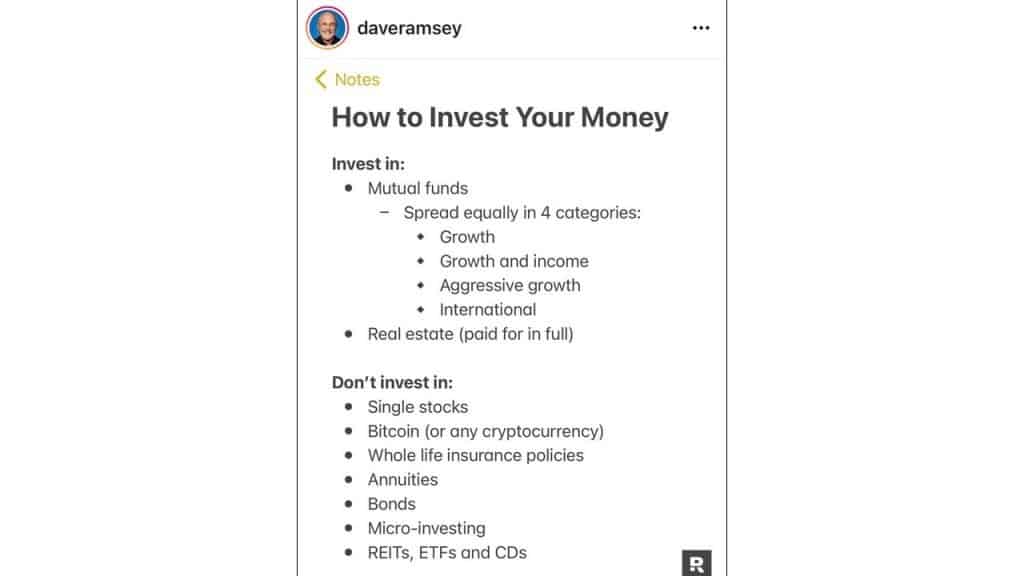The Dave Ramsey Baby Steps program is one of the most popular debt relief programs out there. He has a book called The Total Money Make Over, and he emphasizes getting out of debt. This may sound great for most people, but if you realize that Dave Ramsey has been using the same program since 1992, you may question some of his steps.
These steps do help lots of people get out of debt. There is no denial in this. He does a great job just going in there with a black and white no-nonsense way of helping people out. Once you start to dive into these steps, you realize they are outdated and there are better ways of doing things.
I want to dive down into some of the pros and cons of these baby steps. What are some things we can take from them and some things we can leave behind? A strategy created over 25 years ago may not work in our modern era.
Here are The Dave Ramsey Baby Steps
- Baby Step #1: Save $1000 for Your Emergency Fund
- Baby Step #2: Pay Off All Debt (except the house)
- Baby Step #3 Save 3-6 Months of Expenses
- Baby Step #4: Invest 15%
- Baby Step #5: Save for College
- Baby Step #6: Pay off House
- Baby Step #7: Build Wealth and Give
Many of these look good on the surface, but most of these things are outdated from 1992, and Dave has not updated them for the modern era. He also comes up with some new things that make people go “huh..”
His Twitter page posted a tweet about what to invest in and what not to invest in.

On the Don’t Invest in Categories, he said:
- Single Stocks
- Bitcoin (or any cryptocurrency
- Whole Life Insurance Policies
- Annuities
- Bonds
- Micro-investing
- REITs, ETFs, and CDs
As we look at this list, you have to wonder about some of these things. First of all, ETFs are just the stock version of a mutual fund, and you can buy some great ETFs like VTI, VOO, and VGT (Total Market, S&P500, and Tech).
I am no financial guru, but why advise against investing in simple total market index fund ETFs. It seems like he has some monetary gain for pushing certain mutual funds.
Then REITs are a great way to own real estate without the whole part about managing it yourself. Great dividends come from this as well.
What about Bonds? Warren Buffett mentions owning at least 10% of bonds as a retiree just for some stable investments.
So who is Dave Ramsey really trying to help now? If the things he publishes seem a little out there, his outdated baby steps are not that much farther behind.
The Good of Dave
This may be an unpopular opinion, but Dave Ramsey is not that bad at getting people to get rid of debt. There may be many terrible things about Dave Ramsey, but we will not go into those things. His program really does help people, and I know many people that have used the Debt Snowball to get out of debt. Not every debt method is helpful, but Dave is helping people.
Let’s not diminish his accomplishments. If he can help people get out of debt, then that is a great accomplishment. At the same time, you have to wonder why he still has been using the same material for over 25 years. It is about time to change it up and make it applicable for people now.
Let’s See how we can make The Dave Ramsey Baby Steps work for this modern era.
Baby Step #1: Save $1000 for an Emergency:
Saving $1000 for an emergency is an excellent start to help you fight off debt and create a path to wealth. It is a good start. The $1000 emergency fund will not do as much as it did in 1992. Inflation has really pushed this number much higher. $1000 is worth now $1936. This is probably more realistic for people when dealing with emergencies.
Emergencies happen all the time. If something breaks in your car or on your house, you need to find the cash to pay for these things. The good thing is that if you have an emergency fund, then you are doing better than about 60% of Americans. According to CNBC, only about 39% of Americans can cover a $1000 emergency. This is when people need to start saving and having the amount of money for emergencies.
As I said, this needs to be a lot more. Even Dave Ramsey says this on news networks but doesn’t change his view on his baby steps. He said during the pandemic, if you needed a stimulus check for $600 or $1400, then “you were pretty much screwed already.”
This guy preaches to save $1000, but $600 or even $1400 means you are already screwed. Why would I keep taking his advice if he is contradictory like this? It is more as if he is saying, “do as I say, not as I think.”
If you really want to make it on the right track, start by getting $2000 instead of the $1000 saved. I know it is hard, but emergencies happen. It is a matter of having peace of mind instead of worrying about getting into more debt.
Make saving fun with Yotta Savings. It helps you to save while having a chance to win money.
Baby Step # 2: Pay off All Debt via Debt Snowball (except your house)
The Dave Ramsey Baby Steps program became famous off of the Debt Snowball method. Let me quickly explain it.
The Debt Snowball Method is a way of getting rid of debt but focusing on the smaller debts first and using the psychological win as a way to push you to the finish line. So you organize your debt by smallest to most significant and start knocking off the smallest first.
In this baby step, you will knock out all debt except your mortgage. That one is later on in his baby steps.
Many people do the Debt Snowball method. It is famous for a reason, and it works. This method helps people feel like they are succeeding at knocking out debt. That is a motivator to keep going.
The Debt Avalanche Method
My preferred method is the Debt Avalanche Method. It does not give you that endorphin high from knocking out all the small amounts. It is geared to knock out the high-interest rate debts first.
You make a list of from highest to lowest based upon interest rates. Compounding interest can really wreck your finances, especially if you have credit card debt.
The goal is to knock out those high-interest debts and work yourself down the list. This method is the one that will save you the most money. It does not give you the high the Debt Snowball will provide you with, but it will save you the most money in the long run, and it will also be the quickest way to knock out debt.
It is your choice. Do not go blindly with Dave Ramsey’s Baby Steps. Try to figure out which method would work best for you.
Baby Step # 3: Save 3-6 Months of Expenses
Many people need an emergency fund to bring peace of mind or even replace their income in case of a loss of a job. Three months of expenses can be fine for some. This baby step is to help you to create a cushion after you have paid off all debt.
For most people, three months is not a long time to find a job. I have been there looking for a job. At the three-month mark, you get to the point of settling just because you need the money. This is not always the best for your career or money situation.
Working on having a 6-month emergency fund is much better. It gives you more peace of mind and helps you when you are down on your luck with job hunting. Not everyone will feel this is true, but it helps
Baby Step #4: Invest 15% of Your Income for Retirement
The Dave Ramsey Baby Steps now get you to start investing after paying off all of your debt. Why so late in the game? Investing should be something you start early. Paying off debt is enormous, but even a little money going towards your retirement can really help the compounding snowball make things move.
One of the easiest ways to make free money in your retirement accounts is to get the free match from employers on your 401ks. If your employer offers a 401k and gives a match, why not grab that free money and make your retirement grow.
My last company offered a 401k and gave us 3% after investing 5%. It was free money, and I didn’t want to leave that on the table. I was pretty shocked that other people decided not to enroll in the 401k. It was something they either were not educated about or didn’t think about getting into.
With Dave mentioning just 15% is not a lot of money to be put towards your retirement. At a 15% savings rate for your retirement would put you at retiring in 43 years. That is a whole lot of years, and it is even more if you had spent a lot of time trying to pay off your debt. 20-25% can cut your working years down to 32-37 years, which is more doable.
A lot of us leave school with student loan debt. At age 32-35, you would have paid off that debt. After that, if you are saving around 20-25%, you can retire in your 60s. With 43 years, you will stop working in your 70s.
As a financial person like Dave puts himself to be, I would rather him advocate trying to get people to invest early and invest more than the 15% once they are out of debt. The worst thing in the world is to retire poor.
Invest Simply with M1 Finance. You can easily set up a 3-Fund portfolio and automate everything. Get $30 for free if you deposit $100 with this link. Make life simpler.
Baby Step #5: Save For Your Children’s College Fund
Dave recommends you save for your children’s college fund in a 529 plan. It is an excellent plan to help save for them to get to college.
This sounds great. One of the best things to do is set up your child for financial success. It is better to have them learn financial literacy and have them work through college as well. I know through my years I worked while I studied, and this helped pay for some of my schooling and other expenses that may come up.
Here is the thing, just do what you think you can make happen. Some people fund a 529 plan or some that prefer a UTMA/UGMA that creates generational wealth.
I want my children to have financial literacy when they go to school. Plus, if you are a parent and do not have the money to fund your retirement, that may be more paramount. It may hurt the child more to support their parents while not building up their wealth financially. I see this with friends, where their parents were not good with money, and now they have to financially support their parents as they do not save money for themselves.
This is all a personal choice for you.
Baby Step #6: Pay off Your House Early

This is a considerable debate about paying off your house early. This was not the early 90s when interest rates were high. The interest rates are pretty low these days, and there is no compounding interest on the mortgage. So why would you pay off your mortgage early when you can invest that money instead.
People will often say they would like to have peace of mind of not paying rent, so they pay off their mortgage early. That is an excellent thought and a great plan as well.
On top of the already 15%, Dave Ramsey recommends it is good to knock out the mortgage. I prefer to go the 30-year route instead of Dave’s 15-year route. It may be more peace of mind with the 15-year mortgage, but I think I find more peace of mind investing more. Financially speaking, you would make more with a 30-year mortgage.
It is your choice. You can pick your route.
Baby Step # 7: Build Wealth and Give
This baby step is a good one to agree on. Once all debt is knocked off and you are investing money, it is time to build more wealth and give. It is time to build wealth and be generous.
The part of this I do not understand is Dave’s investing advice. He claims that you should invest in growth mutual funds, and on average, should return 12%. I do not know of any funds that can consistently return 12%. These mutual funds are probably charging fees of 1-2%, which cuts this down closer to 10%.
The S&P 500 has historically returned around 10%. If you take inflation out of that, then it is closer to 7-8%. This is just the market.
I prefer to invest in index funds. They are low-cost and match the market. You do not need a financial advisor taking out 1-2% of our return in fees to do the same thing he does. Make it simple and invest in a fund like VTSAX. You can even get the ETF, VTI as well.
These will really help your money grow. The more money you invest, the better your financial situation will be when entering retirement.
Final Thoughts
The Dave Ramsey Baby Steps are not perfect. It is a system he created in 1992 and he has not changed his views since then. We need to see how the world has changed and adapt our thinking.
I have tried to give my thoughts and how things have changed in the last 25+ years. So take what Dave gives you, but adjust it to your lifestyle. Make actions to learn about financial literacy so you can make the best decisions for your life.
Here are his steps again:
- Step 1: Save $1000
- Step 2: Pay off all debt (Debt Snowball)
- Step 3: Save 3-6 months of expenses
- Step 4: Invest 15% towards retirement.
- Step 5: Save for your children’s college
- Step 6: Pay off your mortgage early
- Step 7: Build Wealth and Give.

I’m Steve. I’m an English Teacher, traveler, and an avid outdoorsman. If you’d like to comment, ask a question, or simply say hi, leave me a message here, on Twitter (@thefrugalexpat1). Many of my posts have been written to help those in their journey to financial independence. I am on my journey, and as I learn more I hope to share more. And as always, thanks for reading The Frugal Expat.








I don’t understand debt payment plans lol. It’s like… You have debt? You have leftover money? Use one to pay off the other. Rinse and repeat.
I was surprised he was able to create like entire steps to actually doing it.
Either ways, not all financial systems are perfect. Just have to stick with one you know.
I love this, and totally agree. There seems to be this love-him-or-hate-him thing going around, which I’m not a big fan of, and you avoid it nicely. It’s okay to disagree with parts of someone’s methodology without calling for pitchforks and torches.
Dave does help people because he inspires them to get out of debt. But, I’m with you, and I think his 7 steps could use some tweaking. I like the adjustments you make in your article. I tweaked his 7-step plan into a 12-step plan, and that works for me.
Following a plan is more important than the nuance of the plan. Find one that works for you and do it!
Great article, thanks for sharing.
Dave gets a lot of hate from people, but he also helps people get out of debt and create some financial discipline. Find the plan that works for you.
In the end it’s become what all popular methods become, an oversimplified ‘boomer logic’ guide.
It is useful, when it applies to you, could it be more useful? Absolutely IMO.
I think the globally minded digital generation need something a bit more relevant while keeping the core ones you mentioned such as Emergency funds and debt management.
As technology improves we also need to improve our methods and plans. The world is changing so you must change with it.
His steps are super basic but they are a really good starting point. He has helped many people get out of debt and there is a reason for that. His steps are basic and basic works.
His advice pretty sound but I always cringe at this kind of thing because it doesn’t really help people whose primary problem is they don’t have any money. His steps are great but the missing step is career acceleration and salary negotiation.
People that don’t have money have issues with using things like the baby steps. You need to learn how to negotiate salary and find steps to make more money with your career. I totally agree with this.
Great breakdown on Dave’s baby steps. I have to admit; I started my financial journey about 5 years ago with the baby steps when I was paying off my student loan debt.
As you pointed out in your analysis, they are great for the most part for those looking to get out of debt but leave a lot to be desired when it comes to investing.
Getting people out of debt is like the best thing Dave’s baby steps do. I am a debt avalanche guy, but debt snowball can really push people and help them out as well.
I wonder what he has against REIT’s and ETF’s? That is kind of strange. He has good points, like encouraging people to get out of debt, but I wouldn’t necessarily take all his advice. I never got on board with a simple $1,000 e-fund, or not contributing to retirement when you’re getting a match. You still have to pay taxes out of your paycheck, why not keep getting that “free money” from your company? I didn’t feel like that was dividing one’s focus.
Exactly. It was strange that he doesn’t like those things. Why not get that free match. It is free money.
Hi Steve, nice article!
May I suggest that instead of repeating Dave’s steps at the end of the article, why don’t you instead share YOUR suggested steps after the revisions? All your points make a lot of sense to me, so it might help readers to have an easy overview of “updated babysteps”.
All the best!
Thank you for the suggestion. It is a great idea to post my simple baby steps that have been modified from Dave’s steps.